The territory of Russia is huge, and therefore the climatic conditions in its various regions are quite different. Each belt has some common features: temperature and precipitation regimes depending on the season. But at the same time, depending on various factors (for example, from the proximity of the ocean), they may vary slightly within the same climatic zone. These differences are especially characteristic for the temperate climatic zone, which is divided into four climatic zones. This is the result of the great extent of the territory of Russia from west to east.
Arctic climate
In this climatic region there are zones arctic deserts and tundra. Here the earth's surface warms up rather weakly, which is the reason for such harsh conditions and, as a result, the vegetation and animal world this area is rather sparse. In addition to the fact that cold air reigns here throughout the year, the severity climatic conditions also exacerbate long polar nights. The air temperature in winter can drop to -60 ° C. Winter in this climatic zone is extremely long (it lasts about 10 months). The number of seasons here is reduced to two: spring and autumn are absent. Summers are also quite cold (temperatures usually do not rise above 5 ° C).
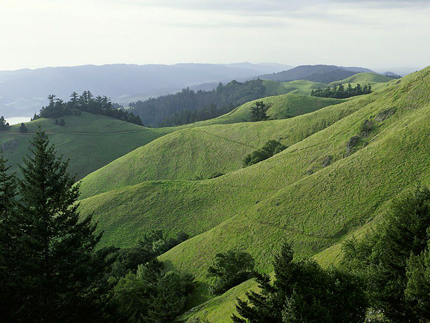
Arkhangelsk region, summer
On the islands of the Arctic Ocean, the temperature in winter is slightly higher. This is due to the fact that the water masses that have accumulated heat give it to the air. In the western part of the Arctic belt, where the influence of the warm North Atlantic Current affects, average annual temperatures also slightly higher. On the islands, rainfall in the Arctic is quite limited. They usually fall out in the form of snow.
Subarctic climate
Winters in this climatic zone are rather long and cold, although still less severe than in the Arctic. Summers are slightly warmer (up to 12ºC), but also quite short. The amount of precipitation is approximately the same as in the Arctic zone (200-400 mm per year). They fall out more often than in the Arctic, but in quantitative terms they are inferior to them. The subarctic climate is also characterized by cloudiness and strong winds. This is due to the passage of Arctic cyclones.
Temperate climate
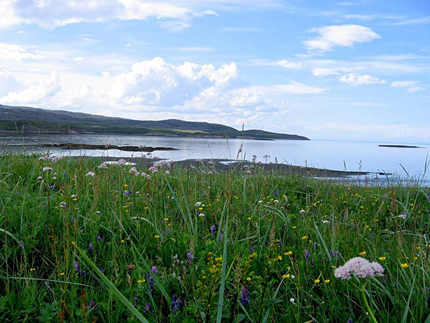
Kola Peninsula
This is the largest climatic zone in Russia in terms of area. That is why it is customary to divide it into four zones: temperate continental, continental, sharply continental, monsoon climate... A characteristic feature of the entire temperate climatic zone is the presence of clearly defined four seasons: spring, summer, autumn and winter. Moreover temperature conditions summers and winters differ quite sharply from each other.
Moderate continental climate
The main features of this type of temperate climate are hot summers (in its middle, the temperature rises to 30 ° C) and frosty winters (the temperature drops to -30 ° C). Rainfall varies depending on the proximity to the Atlantic. The formation of the climate occurs under the influence of the transfer of the Atlantic air masses... Humidification in the moderate continental climate zone varies from excessive in the north, northwest, to insufficient in the south, southeast. This is the reason for the change in natural zones (from taiga to steppe). The air masses of the Atlantic, moving inland, acquire more and more continental properties.
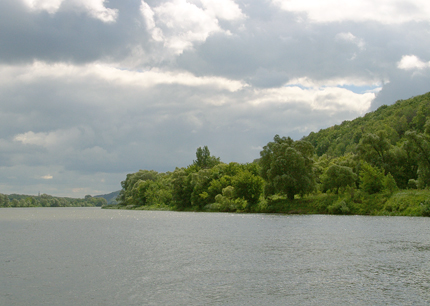
Voronezh region, Don river
It is formed under the influence of air masses of temperate latitudes coming from the west. At the same time, colder arctic air masses are moving from north to south, and continental tropical air is moving to the north. As a result, the north receives 3 times more precipitation than the south. Here the difference between summer and winter temperatures increases even more. average temperature in July it reaches 26 ° C, and in January -25 ° C. The natural zones of the continental climate also change in the direction from north to south from taiga to steppe.
Sharply continental climate
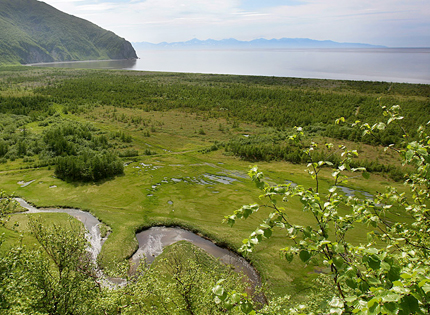
Magadan region, environs of the village. Atargan
This climatic zone is dominated by the continental air of temperate latitudes. Characteristic feature the sharply continental climate is little cloudy and a small amount atmospheric precipitation that fall mainly in the warm season. In addition, due to low cloud cover, the earth's surface warms up rather quickly in summer and cools down in winter. The result is hot summers and frosty winters. Low precipitation in winter contributes to strong soil freezing and preservation permafrost... Within this climatic zone there is only one natural zone - the taiga. This is due to the fact that within the sharply continental climate there are practically no temperature differences between north and south.
Monsoon climate
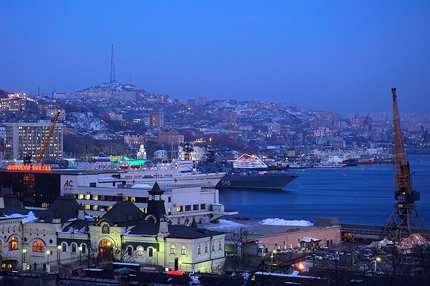
Vladivostok
As the continent cools in winter, the Atmosphere pressure, and cold and dry air masses move towards the ocean, where the air is warmer (water cools more slowly). In summer, the mainland warms up better than the ocean, and cold air from the ocean rushes to the continent. This creates strong winds called monsoons, hence the name of the climate. Sometimes typhoons even form here. In this regard, precipitation also falls mostly in summer and in fairly large quantities. If they start at the time of melting snow, then floods usually occur in these places. Humidification throughout this climatic zone is excessive. Since in summer enough cold air enters this territory from the north, it is quite cool here (the average temperature in July is 15-20 ° C). In winter, the temperature sometimes drops to 40 ° C (average about 25 ° C).
There are no other climatic zones (subtropical, tropical, equatorial) in Russia.
So it is for the eastern mountain ranges of Yakutia and the Magadan region. It is most pronounced and. V mountain ranges separate narrow West Coast from the maritime regions with continental climate. Unlike North America Europe is open to free entry sea air with . This is facilitated not only by the dominant temperate latitudes the transfer of air masses from the west, but also the relief, strong indented coasts and deeply protruding into the land and, and their bays. As the Atlantic air moves inland, it turns into continental air, and the climate becomes more severe. In January, the temperature: in Berlin 0 °, in Warsaw -3 °, in Moscow -1 G, at -19 ° C.
Cooling down occurs during the winter months the earth's surface and air, which is the reason for the formation of the Asian (Siberian) anticyclone, when the air is cooled down to -30, -40 ° C on average. Asian covers the whole of Eastern and Western Siberia, and, and at times extends to southeastern Europe, therefore even in January it is -3 ° С, i.e., as in Warsaw, which is located 1000 km to the north.
Due to the smaller size of North America and the frequent passage, the winter Canadian anticyclone is less stable than the Asian one. Winters are less severe here, and the severity of winters does not increase towards the center of the mainland, as in Asia, but even decreases somewhat due to frequent invasions of tropical air from the bay. Frequent winter cyclones lead to sharp fluctuations in temperature, especially in northern Europe, and. For example, in Moscow in January it can change within a few days by more than 10 °. Thaws can be replaced by severe frosts (down to -30 ° and below). In winter, precipitation falls in the form of snow and is established, which protects against deep freezing and creates a supply of moisture in the spring. The stable is formed to the east of, and its maximum height reaches 90 cm in the eastern regions of Europe and in Western Siberia.
In summer, as in winter, maritime temperate air penetrates, but at this time of the year it is colder than the air that was previously on the mainland. In addition, Arctic air comes from the north quite often in summer. However, a large amount of solar heat in summer quickly warms up the cold ones entering the continent of Eurasia, which turn into warm continental ones. Summers are usually warm, the average monthly temperature in July in Berlin is + 18.3 °; in Warsaw + 19 °; in Moscow + 18.1 °; in Novosibirsk + 18.7 °; over all Eurasia - from + 16 to + 22 ° С. Annual changes from 300 to 800 mm, on windward slopes - more than 2000 mm. Most of them fall out in summer. In Eurasia, the amount of precipitation decreases from west to east, in North America - vice versa. In the south-east of Europe and in southern regions In Asia, where the precipitation is less than 400 mm, the possible evaporation exceeds the precipitation and natural moisture is insufficient. Droughts often occur here.
Continental climate- a type of climate characterized by stably hot summers, stably frosty winters and low rainfall. The continental climate is formed as a result of the prevailing impact on the atmosphere of large land masses. This type of climate is typical for the interior regions of the continents. The continental climate is dominant in a significant part of the territory of Russia, Ukraine, countries Central Asia(e.g. Kazakhstan, Uzbekistan), Mongolia and the interior regions of the United States and Canada. The continent with the greatest continental climate is Eurasia. The continental climate leads to the formation of steppes and deserts, since most of the moisture of the seas and oceans does not reach the inland regions.
Continental climate of temperate latitudes
In temperate latitudes, the continental climate is characterized by a large annual amplitude air temperature (hot summers and cold winters), as well as significant temperature changes during the day (especially during transitional seasons). The continental climate differs from the maritime climate by a lower average annual temperature and humidity, in some cases by increased dustiness of the air. The continental climate is characterized by rather low clouds and low annual quantity precipitation, the maximum of which occurs in the summer. Frequent strong winds, dust storms occur in severely arid regions.
Continental climate of the tropics
In the continental climate of the tropics, annual fluctuations in air temperature are not as great as in temperate latitudes, and there is little or very little precipitation. Continental climate in tropical latitudes usually results in deserts and semi-deserts. Summer in the deserts is extremely hot (up to 55 degrees Celsius), in winter there are sometimes frosts. The average temperature of the coldest month of the year is usually above +15 degrees, in summer the average monthly temperature can reach +40 degrees and above.
Continental climate of polar latitudes
V polar latitudes, the continental climate is characterized by large annual fluctuations in air temperature and warm, but short summers, as well as very cold and long winters. So, for example, in the continental climate of the Republic of Sakha, Evenkia and the continental regions of the Magadan region, the temperature in January in some settlements can drop below -65 ° C (Batamay, Verkhoyansk, Delyankir, Iema, Kochumdek, Maly Tuostakh, Oymyakon, Pokrovsk, Severo-Yeniseisky, Tembenchi, Tomtor, Tura, Kharbalakh, Khonuu, Churapcha). At the same time, the average monthly temperature of the coldest month near the cold pole reaches -54 degrees.
Relationship with other types of climate
The continental climate can, in a weakened form, spread to the parts of the oceans closest to the continents, when air masses flow from the mainland to the territory above the ocean throughout the year. The continental climate differs from the monsoon climate, which is formed due to the predominant influence of continental air masses in winter and sea air masses in summer. There are gradual transitions between maritime and continental climates, e.g. climate Western Europe mainly marine, European part of Russia - moderate continental, Eastern Siberia- sharply continental, Of the Far East- monsoon.
Continental climate is a subtype of several climatic zones, which is characteristic of the mainland, is remote from the sea and ocean coast. The largest territory of the continental climate is occupied by the continent of Eurasia and the interior regions of North America. The main natural areas the continental climate is deserts and steppes. The area here has insufficient humidity. In this area, summers are long and very hot, while winters are cold and harsh. There is relatively little precipitation.
Moderate continental belt
V temperate climates there is a continental subtype. There is a huge difference between the maximum summer and the minimum winter. During the day, there is also a significant amplitude of temperature fluctuations, especially during the off-season. Due to the low humidity here, there is a lot of dust, and due to strong gusts of wind, dust storms occur. The main amount of precipitation falls in summer.
Continental climate in the tropics
In the tropics, temperature differences are not significant, as in the temperate zone. The average summer temperature reaches +40 degrees Celsius, but it happens even higher. There is no winter here, but in the coldest period the temperature drops to +15 degrees. There is a very small amount of precipitation here. All this leads to the formation of semi-deserts in the tropics, and then deserts in a continental climate.
Continental climate of the polar zone
V polar zone the continental climate is also presented. There is a large amplitude of temperature fluctuations. Winter is extremely harsh and long, frosts are -40 degrees and below. Absolute minimum was recorded -65 degrees Celsius. Summer in polar latitudes in the continental part of the earth happens, but it is very short-lived.
Relationships between different different types of climate
The continental climate develops inland and interacts with several climatic zones... The influence of this climate on parts of the water areas that are located near the mainland was noticed. The continental climate exhibits some interaction with the monsoon one. Dominated in winter continental masses air, and in the summer - sea. All this clearly shows that there are practically no clean types of climate on the planet. In general, the continental climate has a significant impact on the formation of the climate of neighboring belts.




